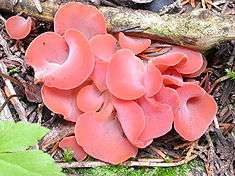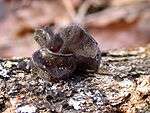Auriculariales
| Auriculariales | |
|---|---|
.jpg) | |
| Auricularia auricula-judae | |
| Scientific classification | |
| Kingdom: | Fungi |
| Division: | Basidiomycota |
| Class: | Agaricomycetes |
| Order: | Auriculariales J. Schröt. (1889) |
| Families | |
|
Aporpiaceae genera incertae sedis (no family)
| |
| Synonyms | |
|
Aporpiales Bond. & M. Bond. (1960) | |
The Auriculariales are an order of fungi in the class Agaricomycetes. Species within the order were formerly referred to the "heterobasidiomycetes" or "jelly fungi", since many have gelatinous basidiocarps (fruit bodies) that produce spores on septate basidia. Around 200 species are known worldwide, placed in six or more families, though the status of these families is currently uncertain. All species in the Auriculariales are believed to be saprotrophic, most growing on dead wood. Fruit bodies of several Auricularia species are cultivated for food on a commercial scale, especially in China.
Taxonomy
History
The order was established in 1889 by German mycologist Joseph Schröter to accommodate species of fungi having "auricularioid" basidia (more or less cylindrical basidia with lateral septa), including many of the rusts and smuts. In 1922, British mycologist Carleton Rea recognized the order as containing the families Auriculariaceae and Ecchynaceae, as well as the rusts (Coleosporiaceae and Pucciniaceae) and the smuts (Ustilaginaceae).[2] Many subsequent authors, however, separated out the rusts and smuts and amalgamated the remaining Auriculariales with the Tremellales.[3][4][5] Jülich (1981) also separated out the rusts and smuts, but recognized the remaining Auriculariales as an independent order, placing within them the families Auriculariaceae, Cystobasidiaceae, Paraphelariaceae, Saccoblastiaceae, Ecchynaceae, Hoehnelomycetaceae, and Patouillardinaceae.[6]
A radical revision was undertaken in 1984, when American mycologist Robert Bandoni used transmission electron microscopy to investigate the ultrastructure of the septal pore apparatus in the Auriculariales. This revealed that species of fungi with "auricularioid" basidia were not necessarily closely related and that Auricularia had more in common with Exidia and its allies (with "tremelloid" basidia), than with other auricularioid fungi. Bandoni therefore amended the Auriculariales to include the family Auriculariaceae (with auricularioid basidia) together with the families Exidiaceae, Aporpiaceae, Hyaloriaceae, and Sebacinaceae (with tremelloid basidia).[7] This revision was accepted by Wells (1994) who, however, amalgamated the Aporpiaceae and Hyaloriaceae and added the families Patouillardinaceae (with diagonally septate basidia) and Tremellodendropsidaceae (with partly septate basidia).[8] Roberts (1998) subsequently added the family Oliveoniaceae (with non-septate basidia).[9]
Current status
Molecular research, based on cladistic analysis of DNA sequences, has substantially supported Bandoni's revised circumscription of the Auriculariales, but has moved the Sebacinaceae to their own separate order, the Sebacinales.[10][11] The status of the constituent families has not yet been examined, but a clade containing Auricularia and Exidia species equates to the Auriculariaceae, whilst another containing Hyaloria and Myxarium species equates to the Hyaloriaceae.[11]
Description
The majority of species within the Auriculariales produce gelatinous basidiocarps (fruit bodies) on dead wood. In some these are conspicuous and may be ear-shaped, button-shaped, lobed, or effused. Their hymenophores (spore-bearing surfaces) may be smooth, warted, veined, toothed (as in the genus Pseudohydnum), or poroid (as in the genera Elmerina and Protomerulius). Some species, however, produce dry, leathery, or web-like fruit bodies resembling those of the corticioid fungi. A few species in the genus Tremellodendropsis produce clavarioid (club or coral-like) fruit bodies.
Distribution and habitat
All species within the Auriculariales are thought to be saprotrophs, most of them wood-rotters. They are typically found on dead attached or fallen wood, though a few (Guepinia and Tremellodendropsis species) are normally found on the ground. As a group, their distribution is cosmopolitan. According to a 2008 estimate, the Auriculariales contain 32 genera and around 200 species.[12]
Economic importance
Several species within the order are edible and two, Auricularia auricula-judae and A. cornea, are cultivated on a commercial scale, particularly in China and southeast Asia. They are widely exported, in a dried or powdered state, as "black fungus", "cloud ears", or "wood ears".[13][14]
-

Guepinia helvelloides (incertae sedis) -

Pseudohydnum gelatinosum
(incertae sedis)
References
- ↑ Kirschner R, Piepenbring M (23 June 2011). "A new pycnidial fungus with clamped hyphae from Central America". Mycological Progress. doi:10.1007/s11557-011-0771-0.
- ↑ Rea C. (1922). British Basidiomycetaceae. A handbook of the larger British fungi. Cambridge University Press.
- ↑ Martin GW. (1945). "The classification of the Tremellales". Mycologia. 37 (5): 527–542. doi:10.2307/3754690. JSTOR 3754690.
- ↑ Donk MA. (1966). "Check list of European hymenomycetous Heterobasidiae". Persoonia. 4: 145–335.
- ↑ Lowy B. (1971). Flora Neotropica 6: Tremellales. New York: Hafner. ISBN 0-89327-220-5.
- ↑ Jülich W. (1981). "Higher taxa of Basidiomycetes". Bibliotheca Mycologica. Cramer. 85.
- ↑ Bandoni RJ. (1984). "The Tremellales and Auriculariales: an alternative classification". Transactions of the Mycological Society of Japan. 25: 489–530.
- ↑ Wells K. (1994). "Jelly fungi, then and now!". Mycologia. 86: 18–48. doi:10.2307/3760717.
- ↑ Roberts P. (1998). "Oliveonia and the origin of the holobasidiomycetes". Folia Cryptogamica Estonica. 33: 127–132.
- ↑ Hibbett DS; et al. (2007). "A higher level phylogenetic classification of the Fungi". Mycological Research. 111 (5): 509–547. doi:10.1016/j.mycres.2007.03.004. PMID 17572334.
- 1 2 Weiss M & Oberwinkler F (2001). "Phylogenetic relationships in Auriculariales and related groups – hypotheses derived from nuclear ribosomal DNA sequences". Mycological Research. 105: 403–415. doi:10.1017/S095375620100363X.
- ↑ Kirk PM, Cannon PF, Minter DW, Stalpers JA, eds. (2008). Dictionary of the Fungi. (10th ed.). Wallingford: CABI. ISBN 978-0-85199-826-8.
- ↑ Black fungus exporters http://www.alibaba.com/product-gs/347644121/Auricularia.html
- ↑ Cloud ears & wood ears http://chinesefood.about.com/library/blchineseing3.htm

